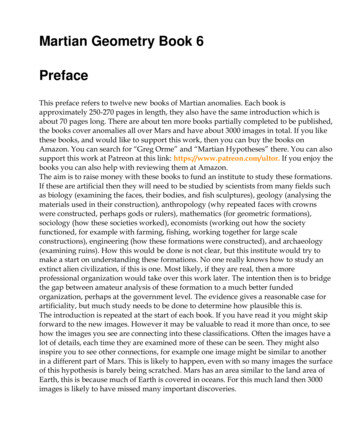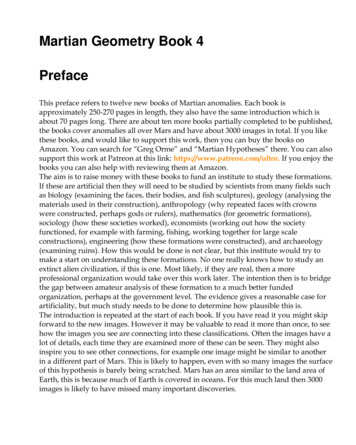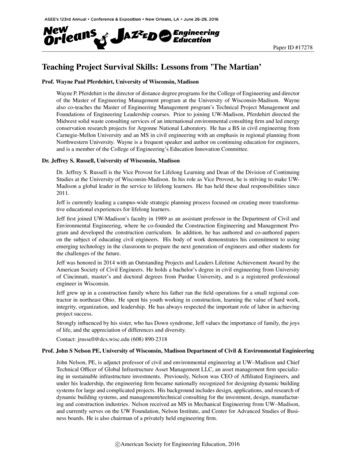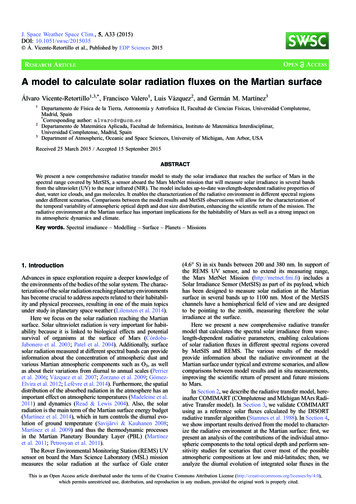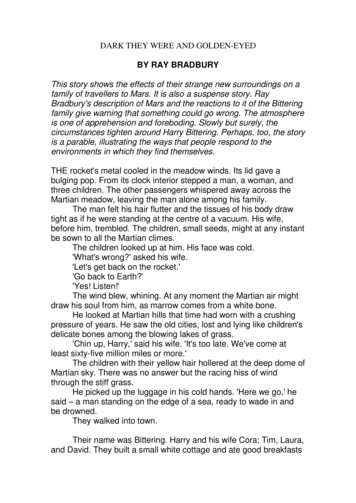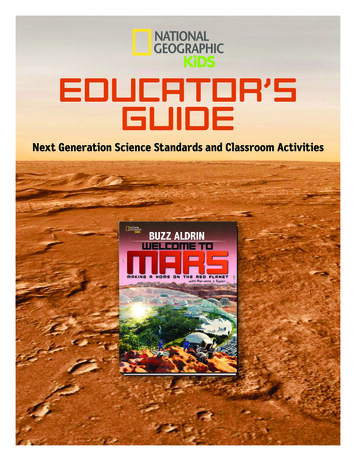
Transcription
Martian Hypotheses Book 8PrefaceThis preface refers to twelve new books of Martian anomalies. Each book isapproximately 250-270 pages in length, they also have the same introduction which isabout 70 pages long. There are about ten more books partially completed to be published,the books cover anomalies all over Mars and have about 3000 images in total. If you likethese books, and would like to support this work, then you can buy the books onAmazon. You can search for “Greg Orme” and “Martian Hypotheses” there. You can alsosupport this work at Patreon at this link: https://www.patreon.com/ultor. If you enjoy thebooks you can also help with reviewing them at Amazon.The aim is to raise money with these books to fund an institute to study these formations.If these are artificial then they will need to be studied by scientists from many fields suchas biology (examining the faces, their bodies, and fish sculptures), geology (analysing thematerials used in their construction), anthropology (why repeated faces with crownswere constructed, perhaps gods or rulers), mathematics (for geometric formations),sociology (how these societies worked), economists (working out how the societyfunctioned, for example with farming, fishing, working together for large scaleconstructions), engineering (how these formations were constructed), and archaeology(examining ruins). How this would be done is not clear, but this institute would try tomake a start on understanding these formations. No one really knows how to study anextinct alien civilization, if this is one. Most likely, if they are real, then a moreprofessional organization would take over this work later. The intention then is to bridgethe gap between amateur analysis of these formation to a much better fundedorganization, perhaps at the government level. The evidence gives a reasonable case forartificiality, but much study needs to be done to determine how plausible this is.The introduction is repeated at the start of each book. If you have read it you might skipforward to the new images. However it may be valuable to read it more than once, to seehow the images you see are connecting into these classifications. Often the images have alot of details, each time they are examined more of these can be seen. They might alsoinspire you to see other connections, for example one image might be similar to anotherin a different part of Mars. This is likely to happen, even with so many images the surfaceof this hypothesis is barely being scratched. Mars has an area similar to the land area ofEarth, this is because much of Earth is covered in oceans. For this much land then 3000images is likely to have missed many important discoveries.
You can also use the indexes in each book, they refer to many similar formationsthroughout them. For example, if you are looking at hypothetical road formations thenroads in many different areas can be found in the indexes. It would be possible then toquickly see all the different kinds of hypothetical roads in all 10 books. The idea behindthe introduction is to give an outline to the global hypothesis, how these differentformations connect together into a hypothetical Martian civilization. It’s important thento get an intuition of how these formations connect together globally.Some areas for example might have hypothetical roads for transport, other might havehypothetical tubes like a covered road. Different terrain, available materials, and climatemight have led to one being used over the other. It may be as Mars cooled it becamenecessary to travel under cover because of the cold. Another possibility is predators ormeteors made traveling on roads too dangerous. Also there are many hypothetical damformations, but the construction techniques vary between areas. Some are formed withdam walls attached to the crater, when they break some show a cavity under them andothers do not. This would indicate the dam wall was dug into this cavity to keep it fromsliding down the crater wall. In other areas this was not necessary, it may be that therethe crater wall was harder rock which the dam wall could be cemented to. Some showcolumns and layers in them but others have evenly spaced vertical grooves on the damwalls. Some dams are excavated out of the crater wall or the material at the bottom of thecrater, these may depend on the rock type in the crater. For example, if the crater wall istoo easily broken then an excavated dam might have been the best engineering solution.Some areas have hollow hills, these are where a hollow habitat may have been built on anexisting hill or the whole hill was constructed. In some areas these have layers similar to aCobler Dome, this is where bricks form the dome in decreasing circles as the dome isbuilt up. These are called amphitheatres as a friendly name, the first amphitheatreformation looked more like seating around an amphitheatre. Other hypotheticalbuildings have no layers in their roofs. This may have depended on the materialsavailable. Many appear to have a smooth skin like cement which has broken up in someparts of the roof, and is intact in others. In many areas this is more intact on the southernside, as the skin breaks off the softer inner parts of the roof appear to have eroded fasterand collapse. The one sided erosion may imply a prevailing wind, or as the oceans andair froze at the pole this created the erosion.There are also large areas of walls and room like shapes, these are hypothetical cities.Other areas connect these hollow hills together with tubes or roads as another kind ofhypothetical city. Still others seem to be made of tubes that connect together inintersections called a tube nexus. This may have been because of the climate further fromthe equator, for example tubes might have been used to travel through in colder areas.
The Martian Faces are mainly discussed in books 11 and 12, a reprint of published peerreviewed papers. These differ according to where they are. The Cydonia Face, Nefertiti,and King Face all fall on a great circle, this is hypothesized to have been an old equatorthat lines up with a known previous pole position west of Hellas Crater. The newlydiscovered Queen Face is in Cydonia but not near the old equator. If the faces were usedto mark latitudes and longitudes then the overall system remains obscure. For examplethere is a large hyperbola shown close to the old equator. Another is far from thisequator, but drawing a line from it to Nefertiti gives a right angle to this old equator.Joining these two hyperbolas and the King Face gives an Isosceles Triangle. Thehypothesis of these mapping system is highly speculative at this stage.Canals, lakes, and water channels also vary in different areas. West of Cydonia there is anextensive array of hypothetical canals, also east and west of Elysium Mons. Some of theseconnect to larger lakes which may be artificial. Some hypothetical dams have waterchannels to direct water into a dam, and to collect an overflow to another dam.There are also darker areas often bounded by walls or geometric shapes. These may havebeen farms, why they appear in some areas like around Cydonia and in Isidis remainsunanswered. Other areas contain hypothetical artefacts but no farm formations, so thesecreatures would have used a different way of collecting food.The idea of these books then is not just to prove artificiality, but to try to prove a globalhypothesis of how the whole civilization functioned. Once the evidence becomesplausible enough, and the shock wears off, this larger question is much more interesting.Each section is labelled with the title hypothesis to make clear these notions are beingproposed along with the evidence there. The sections all have many keywords connectingto the index. If you see a connection to a kind of formation then it is easy to find similarformations. In seeing the global hypothesis the different pieces of the puzzle are morelikely to come together, for example the hypothesis of dams sounds less plausible if it isnot connected to the hypothesis of buildings and farms. Together they give the ideas ofhabitation, food, and water. The conclusions can be controversial. However there is somuch evidence it was better to put it all together into a more comprehensive hypothesis.Otherwise people are looking at isolated formations like faces without seeing the overallcontext in which they appear.Cymd201A shows some cavity shapes which may have collected water. B shows another dam,approximately parabolic.
Cymhh202This shows many hollow hills in stages of collapse, A is approximately symmetricperhaps also using this crater as a dam. C also seems to use a crater, it is unlikely animpact would not break the side of the rim even as the hill collapsed into a pit. There isalso missing ejecta, perhaps used to build the hills. D is more intact but has collapsed onthe right side, E is collapsed to the point of being flat ground. F goes further to collapse toa pit, the pale material should be the same as that for the rooms and ceilings.
Cymhh202aIn this HiRise image of Cymhh202 A shows the pit edge, B confirms this pale material isforming walls and rooms. C shows a ridge which may be an interior support. D showshow the pit edge turns to join the interior support ridge.
Cymhh202bThis shape is unnatural, approximately like an eye. A shows the pit edge appears to havea skin broken off like the hill collapsed leaving it up in the air. This was also seen in manycollapsed hollow hills in Hecates. B shows a narrow groove like an entrance. C shows thebottom of this hill, still sharp like some dam walls. D shows how this pale material isattached to the ridge like some rooms are.Cymhh203This shows another HiRise image, A is a collapsed hill. B shows a collapsed hill at 9o’clock and one collapsed on the edges at 1 o’clock. C shows two more collapsed hills asdoes D. E shows many collapsed hills. F shows a hill more intact on the upper side andcollapsed on the lower side, G is more complete. H shows a partially collapsed hill on thelower side at 7 o’clock.
Cymhh203aA shows an internal ridge. B shows cracks in the pale material like the floor is breakingup. If there were walls here they have eroded away perhaps leaving dark cracks in thefloor. C shows a less eroded area like rooms, it appears to vary in height.
Cymhh203bThere is an impression here from the shadows of three dimensional room shapes. Ashows a wall at 2 o’clock, at 10 and 12 o’clock there appears to be a squarish shape underthe pale material. This may have collapsed as higher rooms eroded covering these in part.B looks to be two long narrow rooms at approximately 45 degrees from horizontal. E alsolooks like three long narrow rooms. C is like a recess in the rock, D may be two more longnarrow rooms. It seems unlikely to be an optical illusion as the light and dark areas areconsistent with shadows.
Cymhh203cThese walls are more like a tetrahedron than cubes, A shows bare walls and a nexus ofwalls partially covered by ceiling material. B also shows a nexus of walls with hollowsaround it. Six walls appear to come together at C. D shows a triangle of walls with onebisecting the base. E shows a corner of two walls with a hollow inside, between D and F itis like a rectangular shallow box suspended by some walls.
Cymhh203c2This shows the possible squarish shape suspended by other walls.
Cymhh203c3This shows how straight some of the other walls are.
Cymhh203dThis shows the pale material eroding away to nothing, forming an empty pit. B and Cshow part of the wall still standing.
Cymhh203eAnother hill having collapsed, the pale material would be more walls and rooms. Ashows where the hill has collapsed. Bis a squarish shape also collapsed with pale materialinside. C shows more pale material. D shows a crack in the intact wall perhaps from thestrain of the other parts having collapsed.
Cymhh203fA shows an intact part of the hill, B the edge where it collapsed. C shows a peak of thehill at 8 o’clock and a collapsed area at 9 o’clock. D shows two room areas, at 4 o’clockthere are several intact rooms. At 8 o’clock there are walls.
Cymhh203gA shows an interior support and T junction, probably a right angle. B shows a wall ingood condition yet the hill above it has collapsed, C shows another wall. D at 4 and 10o’clock shows another wall. D at 8 o’clock shows another wall coming from a T junction.E shows more walls, there are pale squarish shapes like the eroding floors of rooms onthe edges of the pit.
Cymhh203g2The lines show how straight parts of the formation are.
Cymhh203hA may be a crack. B and C shows a meandering line like a road or tunnel through the hill.It is unlikely to be a crack because of its even width as if it is open the whole way. Alsocracks tend not to meander.
Cymhh203iThis looks like a floor that is eroding, the dark lines might be where walls had fitted intothe floor. C shows a pit with no floor material, D shows the edge of the floor with thesedark lines.
Cymhh203jA shows more walls and room shapes, B, C and E show the pale edges of this material. Dshows the intact part of the hill.
Cymhh203kA and B show the edges of this collapsed area, under this the hill appears intact. C lookslike a crack or it has broken a layer here. D shows where this ceiling material is eroding. EF and G show more erosion of this.
Cymhh204A and B show more hills collapsed, C is less eroded but perhaps collapsed in the middle.D at 2 o’clock shows a pit on the side of a crater, this is hard to explain as it looks like thepit came after the crater. It encroaches over the round shape of it. If the hills are so fragilethey can collapse by themselves, then an impact should have collapsed all of it, but onecorner remains standing. E shows a collapsed hill at 10 o’clock and an intact hill at 6o’clock.Cymhh204aThis shows either tubes or internal supports from a hill, it has a different shape with moreright angles to other internal supports. A appears to show collapsed parts of the tubes. Bhas a groove along it like a collapsed tube. D has 5 parallel tubes running off this, theymay end or go to other habitats underground. C is likely to be another tube.
Cymhh204bA shows how the internal support, B connects to it. C appears to be eroded walls. E is theedge of the collapsed hill. D may be a tube or internal support as with F and G.
Cymhhw204cA shows an internal support, B and C show how the collapsed edge has pale materials onthe inside.Cymhh204dA shows some wall shapes in a cavity, B shows some layers which seem to have brokenoff. The layers then may have protected the roof of the hollow hill, when this skindecayed the softer material under this collapsed. This is similar to the hollow hills whenthey collapsed in Hecates. C also shows these broken layers. D shows the layer at 10o’clock and a collapsed cavity is at 12 o’clock. E shows the edge of the hill and how itconnects to this interior support, at H at 8 o’clock, that goes all the way over to the otherside of the hill. F shows possibly the peak of the former hill, G and H at 6 o’clock showspale material that may have been rooms.
Cymhh204eA at 6 o’clock show a hill that has collapsed, at 8 o’clock another shows no signs ofcollapse. The layers shown may be the key to this, as the skin peeled off the hill began tocollapse. B shows an area of the large hill that forms a cavity, the pale material in closeups is usually rooms. Some may not be, for example there may be a pale layer of materialin the ground that is used in walls but in some hills may be undisturbed. C shows anedge at 5 o’clock and a possible collapse at 3 o’clock. D may show settled areas, the cratermay also have been repaired around it. E shows another collapsed area and possiblesettled parts of the roof. Engineers may be able to calculate from modeling these hillshow they might collapse, and what that implies about interior supports in them. Theseusually seem to be too low to hold up the roof, they may then be like domes with no realsupport under them. The interior supports might hold the hill from spreading whichcould cause the roof to flex.
Cymhh204gMore examples of how these walls form rooms, A shows a T junction going down to E at10 o’clock. Other walls appear to crisscross each other, this may to give internal supportto stop the hill edges from flexing. E at 2 o’clock shows a wall with a flat surface andapparent railings, this could have been used like a road so these upturned edgesprevented the creatures from falling off. These are very faint, however many of theseridges like roads have these higher edges like former walls. D shows how these extend tothe edge of the hill, perhaps to connect to external tubes and roads. C to F may have beena room if these walls were higher. B shows a collapsed area with a wall inside it.
Cymhh205A at 7 o’clock and B shows a collapsed hill with much more of this pale material, it maybe this was multiple floors of rooms. A at 2 o’clock shows more wall shapes as if this hillis much more eroded. C is another example, the pale material may have lost its darkouter skin and have quickly collapsed on the right side. This large pit at D at 4 o’clockand E at 1 o’clock has no signs of pale material and may have been completely hollow. Ifso then there were no interior supports helping to hold up the roof, this is also found inthe Hecates area though most have some internal supports. These also were often lowand would not have reached up to the roof.
Cymhh206A shows a pit at 12 o’clock connected with a tube to the more intact hill at 2 o’clock. At 9o’clock there is another collapsed hill. B and C show many imprints like collapsed hillsexcept there is only a shallow pit. These may have filled in over time from dust storms,the roof material could have filled them up, or some did not have a pit under themperhaps because the ground was harder to excavate. Engineers might be able to estimatehow much material was in these roofs and how much of a pit would be filled by it.
Cymhh209aA, B, C, and D show the faint edges of a pit. A and C have sharp edges as if made ofstronger material more resistant to erosion. The inside of the pit is also much smootherwith no large rocks like outside. This would be a likely outcome if the area had beencleared as a construction technique for the hill, some rocks might come up fromunderground over time but not as many as outside this. There is a faint impression ofsome walls and rooms laid out on this, it may also be a cement pad highly eroded andcovered in the same soil as outside it. E shows a curved wall at 4 o’clock, there may havebeen a rectangular room at 10 o’clock, and another at 2 o’clock. If large enough a clearedarea like this might be a good landing spot for a rover to explore the area.
Cymhh209bThis is a closeup of the previous upper left corner, there is a definite impression of a wallgoing from A to C and some parts appear to be higher like a cement pad. B also appearshigher, the texture of the ground is also different to outside this. If this is cement thenrocks would not come from underground, but some might form as the cement broke up.
Cymhh209cThis is a closeup of the curved wall mentioned earlier, A show this wall is broken at 4o’clock. B and C show a curve which is close to two parabolas. D shows this part of thewall is breaking up on the right into separate rocks.
Cymdhh209c2This shows two parabolas superimposed on the curved wall, the latis rectums areapproximately parallel and form a rectangle as they join to the apex of each other. Thiswould be a simple way to build a curved wall so the two curves line up with each other.
Cymhh209dHere the wall is also well preserved, A at 9 o’clock may have been a small hill. Betweenthe B lines appears to be a break in the wall. C may show three walled areas. D shows acontinuation of a possibly collapsed tube with a hollow inside as 12 o’clock, this extendsfrom C at 2 o’clock. D at 5 and 7 o’clock may also show smaller walls at right angles to themain wall pointing downwards.Cymhh209eA may show small rooms with walls, some have right angles. B at 11 o’clock shows a flatarea like a room, at 1 o’clock there is another wall. C shows a curved wall at 10 o’clockand a straight wall at 7 o’clock. D shows a smoothly curved corner leading to a straightwall at 7 o’clock, F shows a fork into two walls. E shows an inner and outer wall herewith a hollow in between like a road with railings.
Martian Hypotheses Book 8 Preface This preface refers to twelve new books of Martian anomalies. Each book is approximately 250-270 pages in length, they also have the same introduction which is about 70 pages long. There are about ten more books partially completed to be published,

